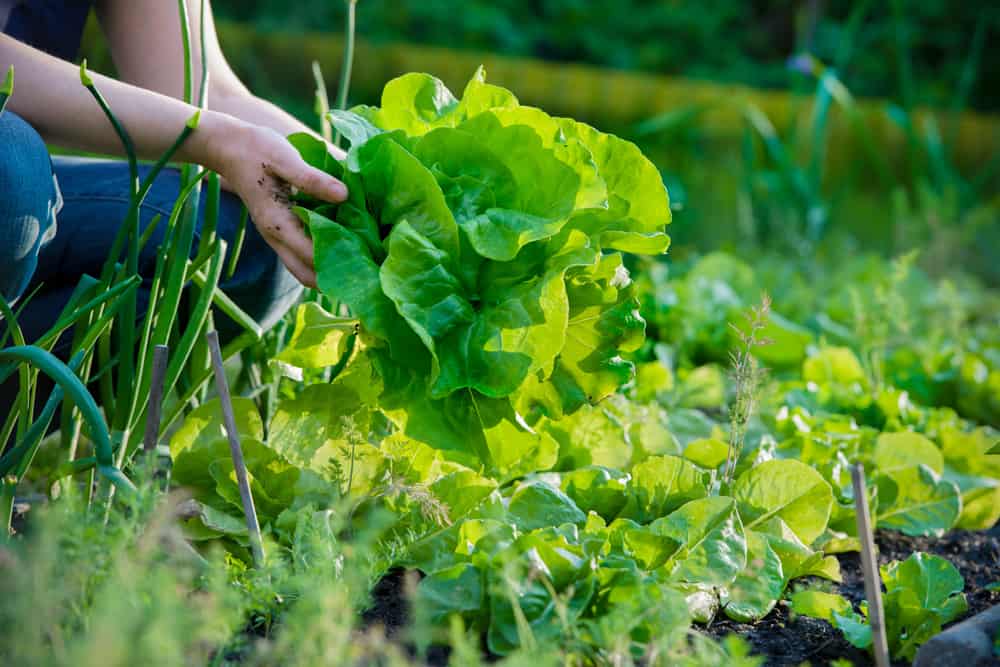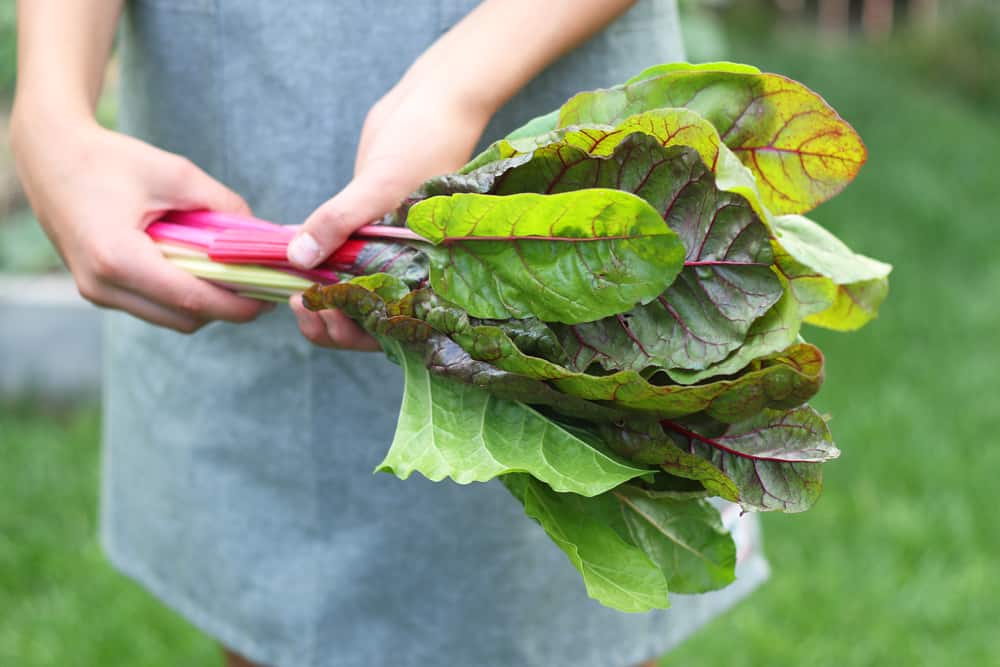8 Reasons To Start A Garden Now
Are you thinking about starting a garden? We’ve got 8 great reasons to get started now. Plus, all the resources you need to start growing organic fruits and vegetables in containers or raised garden beds.

It’s the middle of winter, and as much as I love cozy casseroles and bubbling soups on cold winter nights, right now I’m craving crisp, fresh summer salads.
There’s nothing like opening the back door and picking herbs or veggies straight from the garden. Store-bought bags of limp pre-washed lettuce, mealy tomatoes and tasteless cucumbers just don’t do it for me anymore.
If you’re on the fence about starting a garden this year, I’ve got plenty of good reasons why you should start now.
You may be short on space or intimidated by the thought of a big garden. If so, start small with container gardening. We grow herbs, blueberries and a few varieties of tomatoes in containers every year.
If you have room for raised garden beds, start with one or two and expand when you feel comfortable.
Will this be the year you start a garden? Here are 8 great reasons to start a garden now:

1. Gardening Burns Calories
Okay, so you’re not running a marathon, but all the digging and pulling weeds and planting and stretching and bending burns calories. You’ll burn about 200 to 400 calories for every hour you garden (1).
2. You’ll Eat More Veggies
At our house, our plates are brimming with organic fruits and vegetables straight from the garden. From bushy green kale to vibrant red tomatoes to yellow squash, there’s no better way to get in the daily recommended servings of fruits and vegetables.
Want your kids to eat more veggies? A garden pilot study found that fruit and vegetable consumption more than doubled in children whose parents started a vegetable garden (2).
Growing your own food is a great way to eat a rainbow of colorful, healthy fruits and vegetables all summer long!
3. Gardens Nurture Learning
From planting seedlings to harvesting and cooking, there are so many skills to learn from gardening. It’s a real-world classroom right out your backdoor. Not only do kids get hands-on learning, adults can pick up new skills too. Even seasoned gardeners need to troubleshoot and find solutions when problems arise.
Plant a garden to spur curiosity and learning!
4. Gardening Eases Stress
Spending more time in green spaces reduces stress. Researchers found that residents living in locations with more trees, grass and greenery had lower levels of the stress hormone epinephrine (3).
A 2017 meta-analysis of 22 studies found that gardening is associated with a reduction in depression and anxiety symptoms (4).
I definitely notice my heart rate and breath slowing down when I’m out in the garden harvesting.
5. Gardening Is Budget-Friendly
Aside from a few items like avocados and bananas, I pretty much bypass the produce section of my grocery store in the summer. Our garden churns out all of the produce we need and then some. I haven’t kept track of exact numbers, but our grocery bill is substantially less every summer because of our garden.
You’ll need to make a small investment to start a garden (supplies and seeds), but over the long run you’ll save money.
6. Gardening Protects The Climate
Reduce your carbon footprint by growing your own food. Gardeners that grow enough to replace 20% of bought food reduce their carbon footprint by about 68 lbs of CO2 per year (5)! When leafy plants in a garden absorb carbon dioxide, that creates a positive climate impact or zero-carbon footprint.
7. Gardening Boosts Your Mood
Beyond pigs rolling in dirt, a 2007 study suggests that dirt can make humans feel good too. When the soil bacterium Mycobacterium vaccae was injected in mice, specific immune cells were targeted, releasing chemicals that stimulated serotonin-releasing neurons in the brain (6). These are the same neurons that are activated by Prozac and other antidepressants.
Getting some sunshine (and vitamin D) when gardening boosts your mood too!
8. Gardening Creates A Pollinator Habitat
Welcome wild bees to your yard by planting a garden with different types of heirloom and native fruits, vegetables, herbs, trees and flowers.
Wild bee populations that are critical to crop pollination are decreasing at an alarming rate (7), and providing pesticide-free, bee-friendly native habitats is one way we can make a difference at the local level.

How To Start A Garden
We’ve got all the resources you need to get started gardening. If you’ve never gardened before, we’ve got 8 information-packed posts to get you on your way:
Planning Your Garden Layout
Before you get out your shovel and start digging, we recommend taking some time to decide the best spot for your garden. How many hours of direct sunlight will your garden get? You’ll want at least six hours a day for healthy plant growth. Check out all of out tips for planning your garden layout.
What To Plant In Your Garden
Looking through a seed catalog can make your head spin. Where do you even start? You’ll want to know what growing zone you’re in, and from there we’ve got recommendations for some easy vegetables to start with. Read more about what to plant in your vegetable garden.
Where To Order Seeds
We go over the terms you may come across when buying seeds and where we buy our vegetable seeds. Read more about where to buy seeds for your vegetable garden.
Tips For Maximizing A Small Garden Space
Do you have limited garden space or a short growing season, or both? We have tips and workarounds to increase your harvest yield if you don’t have tons of space. Read our 5 best tips for maximizing your small garden space.
Container Gardening
If you’re still intimidated by the idea of a garden, start small by planting herbs in containers. It’s easy and you’ll boost your gardening confidence in no time. check out our 9 tips for planting herbs in containers, and we share some of our favorite herbs!
Starting Seeds Indoors
We have a short growing season in Colorado, so starting seeds indoors is a must. Discover how to successfully start seeds indoors.
Buidling Raised Garden Beds
Are you ready to build your own raised garden beds? We go through the pros and cons of building your own beds, including dimensions and what to look for in topsoil and compost. Find out more about how to build raised garden beds.
Pest Management
We have an organic gardening strategy that works for us. Read more about how to use organic row covers for pest control.

More Garden Inspiration
References
- https://www.webmd.com/parenting/features/calorie-burners#1
- Heim, S., Stang, J. and Treland, M. A Garden Pilot Project Enhances Fruit and Vegetable Consumption among Children. Journal of the American Dietetic Association. Volume 109, Issue 7, July 2009, Pages 1220-1226.
https://www.sciencedirect.com/science/article/abs/pii/S0002822309004581 - Yeager, R. et al. Association Between Residential Greenness and Cardiovascular Disease Risk. Journal of the American Heart Association. 2018;7.
https://www.ahajournals.org/doi/10.1161/JAHA.118.009117 - Soga, M., Gaston, K. and Yamaura, Y. Gardening is beneficial for health: A meta-analysis. Preventive Medicine Reports. Volume 5, March 2017, Pages 92-99.
https://www.sciencedirect.com/science/article/pii/S2211335516301401 - Bruns, C. 5 Ways Gardening Can Reduce Your Carbon Footprint. Climate Action Business Association. 2015.
https://cabaus.org/2015/03/20/5-ways-gardening-can-reduce-your-carbon-footprint/ - Lowry, C. A., Hollis, J. H., De Vries, A., Pan, B., Brunet, L. R., Hunt, J. RF., … Lightman, S. L. (2007). Identification of an immune-responsive mesolimbocortical serotonergic system: Potential role in regulation of emotional behavior. Neuroscience, 146(2-5), 756 – 772. https://research.monash.edu/en/publications/identification-of-an-immune-responsive-mesolimbocortical-serotone
- Minna E. Mathiasson, Sandra M. Rehan. Status changes in the wild bees of north‐eastern North America over 125 years revealed through museum specimens. Insect Conservation and Diversity, 2019.
https://www.sciencedaily.com/releases/2019/04/190409093801.htm
first image via depositphotos

